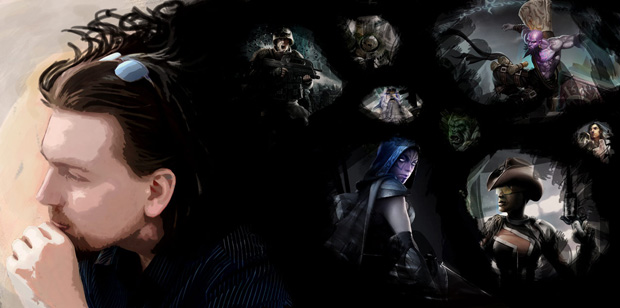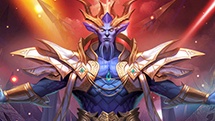By Jason Harper (Hhean), OnRPG’s MOBA Enthusiast
Reading through the comments section of a good number of websites and youtube videos is akin to gazing upon the blood etched runes housed within the fabled necronomicon. There is knowledge there, but it is dark and terrible stuff encrypted within the ramblings of madmen. This year, the comments’ scrawlings have directed their ire towards the emergent MOBA genre, so I thought I’d saddle up my horse, don my white armour and sally forth in defense of gaming’s latest fad.
While dubbing a genre ‘Multiplayer Online Battle Arena’ is a genre name as vague as it gets, the core of what makes up a MOBA is very straightforward. In a MOBA, there are multiple (though most often only two) teams of players that each control a single character within the game. These characters will have a selection of abilities that differentiate themselves from the rest of the cast, and can gain levels and/or items to increase their performance over the course of a match. The objective of each team is to destroy their opposition’s base, while pushing groups of computer controlled mooks down set pathways in order to destroy the towers that obstruct their progress. I’ve seen the term ‘Lane Pushing Game’ or LPS used to describe the genre, and while I personally think it better describes these sorts of games, I’m aware that MOBA is a far more commonly used acronym.
While the first MOBA was the Aeon of Strife map for Starcraft: Broodwar, most of the core elements of the MOBA genre weren’t solidified until the Defense of The Ancients: Allstars map for Warcraft 3: Reign of Chaos. Gas Powered Games’ Demigod was the first MOBA to be released as a stand-alone game, which was a commercial failure due to server issues. Riot Games’ League of Legends (LoL) shortly followed, coining the term ‘MOBA’ in order to set their newly released title apart from DOTA. LoL has since become the most successful MOBA on the market, and is one of the highest grossing video games of all time. Despite its incredible popularity and earnings, LoL has had few imitators. Most MOBAs have been either clones of DOTA or add their own unique ideas onto the standard template.
This is one way that I believe that the MOBA genre is not the cynical cash grab that its detractors often claim it to be. Usually, when a big game comes out it gets a large number of imitators. Not simply games that cherry pick a few key mechanics, but lift the entire mechanical underpinnings of the game alongside nearly all of its thematic components. The worst example of this was found in the wake of World of Warcraft (WoW), which both reinvigorated and stagnated the MMO genre.
WoW is far from the only culprit here, but its imitators were by far the most blatant. Blizzard’s behemoth brought the MMO market out of obscurity, taking it from a niche to one of the largest, most bloated of genres. This should have been great for the genre as competition often breeds innovation. The problem is that due to the extreme cost to make an MMO, only big publishers could even consider funding such a large project. Big publishers with risk adverse investors who only want ‘sure fire’ games to increase the worth of their stock. The result was a veritable deluge of fantasy themed worlds filled with quest logs, hotbars and rat infested basements.
The reason this hasn’t happened to the MOBA genre (so far) is that they are relatively cheap to build. You only need to make one map, a few characters, and have a solid idea of how those characters interact with any available upgrades. You don’t need a story, or cutscenes or quicktime events. Just some artists, programmers and designers. While balancing the game can be a nightmare (especially as potential upgrade/character combinations expand), those simply require a larger than normal QA team, who are the lowest paid workers in the gaming industry. This means that we’re seeing small startup companies leaping at the genre rather than the lumbering AAA publishers.
Independent studies are far more likely to be making games they enjoy and want to play, rather than trying to work out how best to achieve maximum market saturation. They don’t have investors to appease or sprawling amounts of managerial staff desperate to justify their own existence. Risks are far more common in the indie scene, and the MOBA genre has inherited a lot of its pioneering spirit. Third person shooter with MOBA elements? Why not! Platformer hybrid based on 80s cartoon shows? Go for it!
Ironically, this is why most MOBAs are crap. While there’s a good amount of diversity in the genre, no-one but Valve and Riot have the money to throw at their games to polish them to the incredibly high standard its audience now expects. There are few companies working in software, let alone in gaming, that are making the sort of profits those two are raking in. While both LoL and Dota started out as diamonds in the rough, they are now diamonds sporting enough bling to blind a rap star. These new games simply don’t get a chance to prove themselves before their userbase gets consumed by the ever hungry MOBA Monoliths. Even those that do survive past the opening weeks, and manage to gain some traction (Hey SMITE, how you doing over there?) suffer when they are unable to keep pace with the consistent stream of upgrades the two market leaders keep lathering all over their products.
What has succeeded, however, is League of Legends’ business model. The exact way that a game is carved into pieces with pay gates only being put on cosmetic options, then allowing both in-game and real world currency to be used to expand the number of tools at a player’s disposal has become the industry standard. Paying for power has mostly disappeared from new releases, as has paying for sections of content. While the free to play model was in use before LoL, it was considered a second-rate option for western titles until Riot paved the way for a new generation of western F2P games.
Many people would likely rather see more games adopt Dota2’s free to play model that has its users pay for cosmetics only, but I honestly can’t blame the free to play market for not going for such a risky venture. While Valve has Steam backing it if their games don’t turn a profit, no other developer can afford to give things out completely for free just so they can increase the number of people with their distribution platform installed. EA probably could use such a scheme to get Origin into more homes, but they are too busy dealing with their own financial woes in the wake of the abysmal failure that was The Old Republic.
Perhaps in the future we’ll start to see some of the worst parts of the gaming industry at work as the big publishers catch the scent of money and begin warming up the cloning vats. If you were particularly cynical, you could argue that it’s already begun, with tie ins like Guardians of Middle Earth and the upcoming Infinite Crisis trying to make a cheap buck from fans. I like to hope that the future holds more experimentals like Prime World and less survey driven slush like Merc Elite.
In the present though, we have a small roster of different titles that offer more diversity within the borders of the genre than most others could only dream of. Love them or hate them, MOBAs certainly aren’t going away anytime soon.




